

Guitar Nine Records - Guest Column: The Acoustic Guitar In The Mix, Part 2. In a previous article on the acoustic guitar in the mix we looked at compression and equalization.
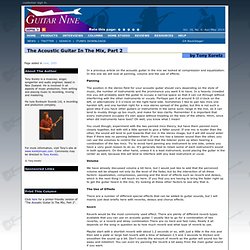
In this one we will look at panning, volume and the use of effects. Panning The position in the stereo field for your acoustic guitar should vary depending on the style of music, the number of instruments and the prominence you want it to have. Audio Mastering In Your Computer. Many home recordists hope to perfect their productions by doing their own mastering on their studio computer.
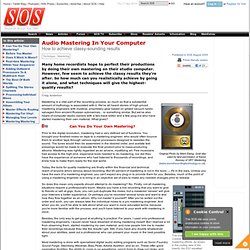
However, few seem to achieve the classy results they're after. So how much can you realistically achieve by going it alone, and what techniques will give the highest-quality results? Craig Anderton Mastering is a vital part of the recording process, so much so that a substantial amount of mythology is associated with it. Mastering on Logic 9? Share your talent in mixing acoustic guitar. Tips: How to use an Audio Compressor. The audio compressor, is a pretty useful item, and one which you need to add to your system at some point if you are recording any type of audio, especially vocals.

The audio compressor automatically adjusts and maintains the signal levels as they go to H/Disk or Tape to be recorded. This compression evens out the distance between loud & quiet parts, by crushing the audio if it gets too loud, and raising the audio in the quiet sections. How to Record Vocals in your Home or Project Studio. By Rich the TweakMeister part 1 part 2 part 3 The Bell rings again.

The Tweak briskly enters the classroom armed with coffee and his box of manuals. Some don't wait a second before shouting out newbie questions Tweak sighs, looks around the class and mutters, "Too many new tweaks here". Tweak slams down the coffee cup. Alright, I'll let you dudes stay, but none of those "What's the best compressor for Fruity Loops" OK?
Overview: It seems easy; you just get some lines of words into an audio track and tweak it down. Laying a Vocal Track using Logic Pro PART One. Download & Stream Tutorial-Video for Logic 401: Logic's Mastering Toolbox. Status Available Released May 20th, 2009.

Better Vocals In Logic. Getting great recorded vocals can seem like rocket science, especially with all the complicated editing and processing tools that Logic now provides.

So this month we'll be giving you the advice you need to produce that big commercial sound. Paul White Recording vocals, in a generic sense, has been covered in Sound On Sound on numerous occasions, but this time we're going to look at the process of recording and processing vocals using Apple's Logic. The process starts with getting a microphone signal into Logic, which usually means connecting a suitable mixer or mic preamp to the line input of your audio interface, or using an audio interface that has a mic preamp built in. Pitch Correction with Logic. Automatic tuning is synonymous with many things, good and bad.
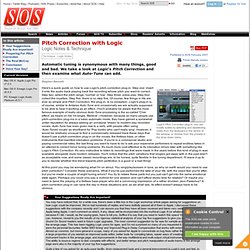
We take a look at Logic's Pitch Correction and then examine what Auto-Tune can add. Stephen Bennett Here's a quick guide on how to use Logic's pitch-correction plug-in. Step one: insert it onto the audio track playing back the recording whose pitch you want to correct. Step two: select the pitch range, 'normal' or 'low'. At this point you may be wondering what I'm on about.
The Ultimate EQ Guide. Please Note - The values below are merely guides, each mix is unique and individual so experimentation is advised.
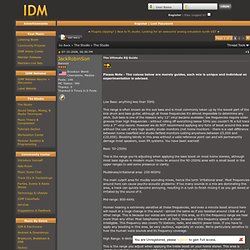
Low Bass: anything less than 50Hz This range is often known as the sub bass and is most commonly taken up by the lowest part of the kick drum and bass guitar, although at these frequencies it's almost impossible to determine any pitch. Sub bass is one of the reasons why 12" vinyl became available: low frequencies require wider grooves than high frequencies - without rolling off everything below 50Hz you couldn't fit a full track onto a 7" vinyl record. However we do NOT recommend applying any form of boost around this area without the use of very high quality studio monitors (not home monitors - there is a vast difference between home nearfield and studio farfield monitors costing anywhere between £5,000 and £20,000). Boosting blindly in this area without a valid reference point can and will permanently damage most speakers, even PA systems. Bass: 50-250Hz. Interactive Frequency Chart - Independent Recording Network.
DdEFt.jpg (JPEG Image, 933x1024 pixels) - Scaled (67. Five Frequency Areas When EQ'ing the Vocal. Equalizing a vocal track can be very tricky.

Sometimes it seems to sound like it was stuck on later, and doesn't flow with the rest of the track. Below are the five frequency ranges you can start with when you are in trouble and need to figure out how to equalize it so it sits with the song. It goes without saying that no amount of EQ'ing is going to fix a badly recorded vocal. Mixing Vocal Track: Step by Step Guide. I am going to show you how I mix my vocal track in one of my songs.
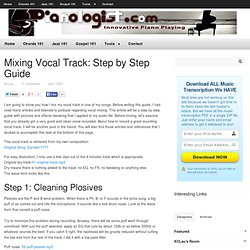
Before writing this guide, I had read many articles and listened to podcast regarding vocal mixing. This article will be a step by step guide with pictures and effects tweaking that I applied to my audio file. Before mixing, let’s assume that you already got a very good and clean vocal recorded. Recording Lead Vocals. Q I'm currently using a dynamic mic for recording vocals, but I've heard that capacitor mics are better. What difference would I notice if I bought one? Tips on how to mix vocals and put some effects like a professional. Vocals are the most important instrument in any audio mixing work. In fact if the vocals are not properly mixed, you can observe a difference between good and poor audio production work. Mixing vocals is therefore a big priority in the audio mixing session. In this article, I will share my personal techniques when it comes to mixing vocals.
I will illustrate those essential principles I have in mind to come up with greatly produced vocals. Bear in mind that this is not a one-setting-fits-all approach and should only serve as a starting point or guide in mixing vocals. Start with the tips illustrated in this tutorial, and then tweak further to get the best vocal sound out of your mix. How to Process Vocals for an Amazing Professional Sound. Persuading a problematic vocal recording to play nicely with the rest of your mix can seem like a futile task. Well-recorded vocals and poorly-recorded vocals both need to be correctly prepared, and the processes we're going through today will help you turn your untreated vocal take into a polished and commercial sound. Note: this tutorial contains embedded audio that will not display in a feed reader.
Click back to the site to read the tutorial with audio or download the Play Pack at the end of the tut. Audio Recording Center: Mixing Made Easy, Article. Most people think mixing is complicated. It's really not. Most pros (myself included) like the fact that there's an air of mystery surrounding what we do. It makes us look smarter. It also allows us to charge more money. But, let's face it. The best way to learn anything is to copy the masters. Take a blank piece of paper and diagram what you hear. Most mixers will mix their instruments from the perspective of the listener or the perspective of the player. When you shut your eyes, you should be able to visualize an aural "landscape. "